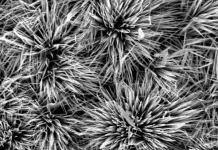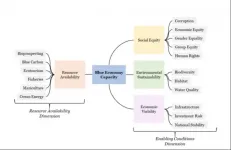(Press-News.org) A sustainable, powerful micro-supercapacitor may be on the horizon, thanks to an international collaboration of researchers from Penn State and the University of Electronic Science and Technology of China. Until now, the high-capacity, fast-charging energy storage devices have been limited by the composition of their electrodes -- the connections responsible for managing the flow of electrons during charging and dispensing energy. Now, researchers have developed a better material to improve connectivity while maintaining recyclability and low cost.
They published their results on Feb. 8 in the Journal of Materials Chemistry A.
"The supercapacitor is a very powerful, energy-dense device with a fast-charging rate, in contrast to the typical battery -- but can we make it more powerful, faster and with a really high retention cycle?" asked Jia Zhu, corresponding author and doctoral student conducting research in the laboratory of Huanyu "Larry" Cheng, Dorothy Quiggle Career Development Professor in Penn State's Department of Engineering Science and Mechanics.
Zhu worked under Cheng's mentorship to explore the connections in a micro-supercapacitor, which they use in their research on small, wearable sensors to monitor vital signs and more. Cobalt oxide, an abundant, inexpensive material that has a theoretically high capacity to quickly transfer energy charges, typically makes up the electrodes. However, the materials that mix with cobalt oxide to make an electrode can react poorly, resulting in a much lower energy capacity than theoretically possible.
The researchers ran simulations of materials from an atomic library to see if adding another material -- also called doping -- could amplify the desired characteristics of cobalt oxide as an electrode by providing extra electrons while minimizing, or entirely removing, the negative effects. They modeled various material species and levels to see how they would interact with cobalt oxide.
"We screened possible materials but found many that might work were too expensive or toxic, so we selected tin," Zhu said. "Tin is widely available at a low cost, and it's not harmful to the environment."
In the simulations, the researchers found that by partially substituting some of the cobalt for tin and binding the material to a commercially available graphene film -- a single-atom thick material that supports electronic materials without changing their properties -- they could fabricate what they called a low-cost, easy-to-develop electrode.
Once the simulations were completed, the team in China conducted experiments to see if the simulation could be actualized.
"The experimental results verified a significantly increased conductivity of the cobalt oxide structure after partial substitution by tin," Zhu said. "The developed device is expected to have promising practical applications as the next-generation energy storage device."
Next, Zhu and Cheng plan to use their own version of graphene film -- a porous foam created by partially cutting and then breaking the material with lasers -- to fabricate a flexible capacitor to allow for easy and fast conductivity.
"The supercapacitor is one key component, but we're also interested in combining with other mechanisms to serve as both an energy harvester and a sensor," Cheng said. "Our goal is to put a lot of functions into a simple, self-powered device."
INFORMATION:
Co-authors on this paper include Yunjian Chen, Ni Wang, Xianzhong Tang and Wencheng Hu, all affiliated with the School of Materials and Energy, University of Electronic Science and Technology of China; and Sridhar Komarneni, Materials Research Institute (MRI) and Department of Ecosystem Science and Management, Penn State. Wang is also affiliated with MRI.
The National Natural Science Foundation of China supported this work.
(BOSTON) ¬-- Human cells typically transcribe half of their roughly 20,000 genes into RNA molecules at any given time. Just like with proteins, the function of those RNA species not only relies on their abundance but also their precise localization within the 3D space of each cell. Many RNA molecules convey gene information from the cell's nucleus to the protein-synthesizing machinery distributed throughout the cytoplasm (messenger RNAs or mRNAs), others are components of that machinery itself, while still different ones regulate genes and their expression, or have functions that remain to be discovered. Importantly, many diseases including cancer and neurological diseases have signatures that appear as changes in the abundance and distribution of RNAs.
To enable the analysis ...
DALLAS - March 17, 2021 - UT Southwestern researchers have identified the structure of a key member of a family of proteins called nicotinic acetylcholine receptors in three different shapes. The work, published online today in Cell, could eventually lead to new pharmaceutical treatments for a large range of diseases or infections including schizophrenia, lung cancer, and even COVID-19.
Nicotinic acetylcholine receptors are members of a broader super-family of proteins called Cys-loop receptors that function as ion channels on cell surfaces and are found in the membranes of many cell types. When the right molecule settles ...
From climate change and carbon emissions to biodiversity and global hunger, humanity faces so many challenges that tackling them quickly is a daunting task. One solution that potentially addresses multiple issues could provide the impetus society needs to make significant progress.
An international team of 26 authors, including six at UC Santa Barbara, has just published a study in the prestigious journal Nature offering a combined solution to several of humanity's most pressing challenges. It is the most comprehensive assessment to date of where strict ocean protection can contribute ...
BOSTON - There are several effective interventions to reduce the risk of suicide, the tenth-leading cause of death in the United States, but difficulties in identifying people at risk for suicide and concerns about the potentially high costs of suicide-prevention strategies have hampered their wider use.
But as researchers at Massachusetts General Hospital (MGH) demonstrate, statistical suicide risk prevention models could be implemented cost-effectively in U.S. health care systems and might help save many lives each year.
By evaluating data on the incidence of suicide and suicide attempts, the costs to society and the health care system of suicide, and the cost and effectiveness of suicide risk-reduction interventions, Eric ...
Increased global temperatures help invasive species establish themselves in ecosystems, new research led by a Swansea University bioscientist has shown.
The study, published by the Royal Society, gives an insight into the probable combined effects of species invasions, which are becoming more common, and global warming.
Climate warming and biological invasions result in the loss of species. They also alter the structure of ecosystems and the ways in which species interact.
While there is already extensive research on how climate change and invasions affect ...
London, UK (17 March 2021)--A new study published in the prestigious peer-reviewed scientific journal Nature today offers a combined solution to several of humanity's most pressing challenges. It is the most comprehensive assessment to date of where strict ocean protection can contribute to a more abundant supply of healthy seafood and provide a cheap, natural solution to address climate change--in addition to protecting embattled species and habitats.
An international team of 26 authors identified specific areas that, if protected, would safeguard over 80% of the habitats for endangered marine species, and increase fishing catches by more than eight million metric tons. The study is also the first to quantify the potential release of carbon dioxide into the ocean ...
One of the best ways to study human evolution is by comparing us with nonhuman species that, evolutionarily speaking, are closely related to us. That closeness can help scientists narrow down precisely what makes us human, but that scope is so narrow it can also be extremely hard to define. To address this complication, researchers from Stanford University have developed a new technique for comparing genetic differences.
Through two separate sets of experiments with this technique, the researchers discovered new genetic differences between humans and chimpanzees. They found a significant ...
Stopping the spread of political misinformation on social media may seem like an impossible task. But a new study co-authored by MIT scholars finds that most people who share false news stories online do so unintentionally, and that their sharing habits can be modified through reminders about accuracy.
When such reminders are displayed, it can increase the gap between the percentage of true news stories and false news stories that people share online, as shown in online experiments that the researchers developed.
"Getting people to think about accuracy makes them more discerning in their sharing, regardless of ideology," says MIT professor David Rand, co-author of a newly published paper detailing the results. "And it translates ...
Among adults with children living in the home, cannabis use was more common in states with legalized cannabis use, according to a new study by Columbia University Mailman School of Public Health, Columbia Irving Medical Center and the City University of New York. Legalization for recreational and medical use were both linked with significantly higher prevalence of past-month and daily cannabis use. Until now, most tobacco control and harm reduction efforts protecting youth from exposure to secondhand tobacco smoke focused on parental cigarette smoking, ensuring smoke-free homes, and not smoking in the presence of children. The findings are published ...
The future of an equitable and sustainable global ocean, or "Blue Economy," depends on more than the resources available for technological advancement and industry expansion. A recent UBC-led study found that socioeconomic and governance conditions such as national stability, corruption and human rights greatly affect the ability to achieve a Blue Economy.
The study, published today in Nature, scored criteria across five global regions: Africa, Americas, Asia, Europe and Oceania, to identify the areas of investment and research necessary to develop ocean resources in a manner that is consistent with a Blue Economy ethos (socially ...



